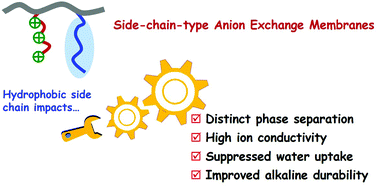Boosting the performance of an anion exchange membrane by the formation of well-connected ion conducting channels†
Abstract
An anion exchange membrane (AEM) with good ion conductivity and high durability is greatly needed in the area of electrochemical energy conversion and storage systems. An AEM with a phase separation morphology has been shown to be an efficient strategy. Here, we randomly tethered a fluorocarbon segment and a tri-quaternary ammonium side chain to the poly(phenylene oxide) (PPO) backbone (PPO-22-3QA8F), aiming to increase the thermodynamic immiscibility between the hydrophobic/hydrophilic units and thereby produce an AEM with better phase separation but suppressed water uptake. With the premise of similar ion contents, two AEMs tethered with tri-quaternary ammonium (PPO-8-3QA) and benzyltrimethylammonium (PPO-22-QA) were synthesized for comparison. Incorporating an additional hydrophobic side chain turned out to be an effective way to drive the membrane's phase separation and the formation of well-connected ion conducting channels. PPO-22-3QA8F exhibited the highest hydroxide conductivity among the three AEMs up to 83 mS cm−1 in Milli-Q water at 90 °C, which is over 2 times higher than that of PPO-8-3QA (39 mS cm−1) and PPO-22-QA (27 mS cm−1). In addition, PPO-22-3QA8F exhibited a reasonable water uptake of less than 20 wt% at room temperature and excellent alkaline stability in 1 M NaOH at 80 °C for 7 days. As the immersion time was extended to 21 days, the PPO-22-3QA8F membrane was ductile and retained 51% of its original conductivity, while the other two controls were broken to pieces. A H2/O2 fuel cell prototype was evaluated using the PPO-22-3QA8F membrane as a separator to achieve a peak power density of 102 mW cm−2, which was nearly 3 times higher than that of the PPO-8-3QA membrane (38 mW cm−2) under the same operating conditions. Overall, the results of this study provide an efficient strategy to guide the architectural design of high-performance AEMs.



 Please wait while we load your content...
Please wait while we load your content...